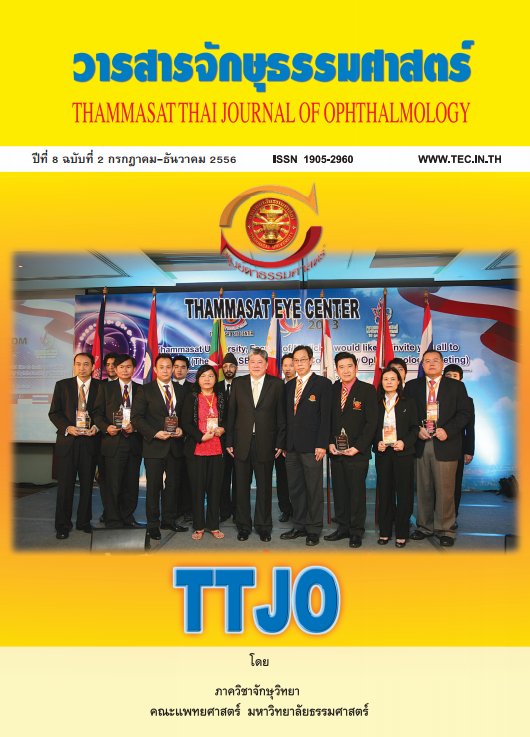การเปรียบเทียบระดับน้ำตาลสะสมของผู้ป่วยที่มีภาวะเบาหวาน ขึ้นจอประสาทตากับผู้ป่วยที่ไม่มีภาวะเบาหวานขึ้นจอประสาทตา
Main Article Content
Abstract
ความเป็นมา: องค์การอนามัยโลก และสมาคมโรคเบาหวานอเมริกัน ได้กำหนดค่าระดับน้ำตาลที่ใช้ประเมินภาวะเบาหวานขึ้นจอประสาทตา แต่ปัจจุบันการตรวจระดับน้ำตาลสะสม (HbA1c) สามารถช่วยประเมินการควบคุมระดับน้ำตาลของผู้ป่วยได้ดีกว่าการตรวจระดับ
น้ำตาลในพลาสมาก่อนอาหาร (FPG) และยังมีการศึกษาเปรียบเทียบระดับน้ำตาลสะสมของผู้ป่วยที่มีภาวะเบาหวานขึ้นจอประสาทตากับผู้ป่วยที่ไม่มีภาวะเบาหวานขึ้นจอประสาทตาน้อยมาก
รูปแบบการศึกษา: การศึกษาเชิงวิเคราะห์แบบ crosssectional analytic study ในช่วงเวลาตั้งแต่ 1 มกราคม 2556 ถึง 1 มิถุนายน 2556
กลุ่มเป้าหมาย และวิธีการศึกษา: ผู้ป่วยเบาหวานที่มารับการตรวจที่คลินิกเบาหวานของโรงพยาบาลสมเด็จ
พระบรมราชเทวี ณ ศรีราชา ที่ได้รับการตรวจคัดกรองภาวะเบาหวานขึ้นจอประสาทตาโดยใช้การถ่ายภาพจอตาแบบไม่ต้องขยายม่านตา (non mydriatic retina camera)และจักษุแพทย์ตรวจวินิจฉัยยืนยันโดยใช้ indirect ophthalmoscope โดยรวบรวมข้อมูลลักษณะทั่วไปของผู้ป่วย เพศ อายุ โรคประจำตัว เช่น ความดันโลหิตสูง ไขมันในเส้นเลือด ผลการตรวจจอประสาทตา ระดับน้ำตาลในพลาสมาก่อนอาหาร และระดับน้ำตาลสะสม แล้วนำมา วิเคราะห์ข้อมูล โดยใช้สถิติเชิงพรรณนา chi-square และ independent t-test
ผลการศึกษา: กลุ่มที่มีเบาหวานขึ้นจอประสาทตา (n=157) มีค่าเฉลี่ยน้ำตาลสะสมและมีค่าเฉลี่ยระดับ
น้ำตาลในพลาสมาก่อนอาหารมากกว่าผู้ป่วยกลุ่มที่ ไม่มีเบาหวานขึ้นจอประสาทตา (n=259) (mean (SD) HbA1C=7.4 (1.8) vs. 8.5 (2.2), p<0.001; mean (SD) FPG=168.9 (64.8) vs. 149.8 (46.0), p=0.001) และพบว่าปัจจัย ได้แก่ เพศ อายุ ความดันโลหิตสูง และไขมัน ในเลือดของผู้ป่วยเบาหวานสองกลุ่มนี้ไม่แตกต่างกัน
สรุป: ผู้ป่วยกลุ่มที่มีภาวะเบาหวานขึ้นจอประสาทตามีค่าเฉลี่ยน้ำตาลสะสมมากกว่าผู้ป่วยเบาหวานที่ไม่มี
ภาวะเบาหวานขึ้นจอประสาทตา ผลการศึกษาแสดงให้เห็นว่าการประเมินค่าเฉลี่ยน้ำตาลสะสมมีความสำคัญ ต่อการป้องกันการเกิดภาวะเบาหวานเข้าจอประสาทตา
Comparison of Glycosylated Hemoglobin (HbA1C) between
Diabetic Retinopathy and Non- Diabetic Retinopathy Patients
Abstract
Background: Diabetic retinopathy is the commoncomplication of diabetic disease and a leading causeof blindness. The World Health Organization (WHO) and American Diabetic Association criteria for
diagnosing diabetes mellitus assume the presence of a glycemic threshold with high sensitivity for identify
retinopathy. However, this assumption is based on data from previous studies that had important limitations in detecting retinopathy. This study aimed to provide updated data for the relation between glycosylated hemoglobin (HbA1C) and diabetic retinopathy.
Research design: A cross-sectional analytic study from January 1st, 2013 – June 1st , 2013
Subjects and Methods: Medical records of patients with diabetes mellitus in Queen SavangVadhana Memorial Hospital who underwent diabetic retinopathy screening by using photographs of non mydriatic retina camera and confirmed by ophthalmologist were reviewed. Data were collected and analyzed withdescriptive statistic, Chi-square, and independent t-test.
Results: The diabetic retinopathy (DR group) had significantly greater mean HbA1C and fasting plasma glucose (FPG) than the non-diabetic retinopathy patients (Non DR group) (mean (SD) HbA1C=8.5 (2.2) vs. 7.4 (1.8), p<0.001; mean (SD) FPG=168.9 (64.8) vs. 149.8 (46.0), p=0.001). There was no difference of factors including gender, age, hypertension, and dyslipidemia between the two groups.
Conclusion: Diabetic retinopathy patient had mean HbA1C greater than patients non-diabetic retinopathy patient. The finding pointed to the important of HbA1C assessment for preventing diabetes retinopathy.


